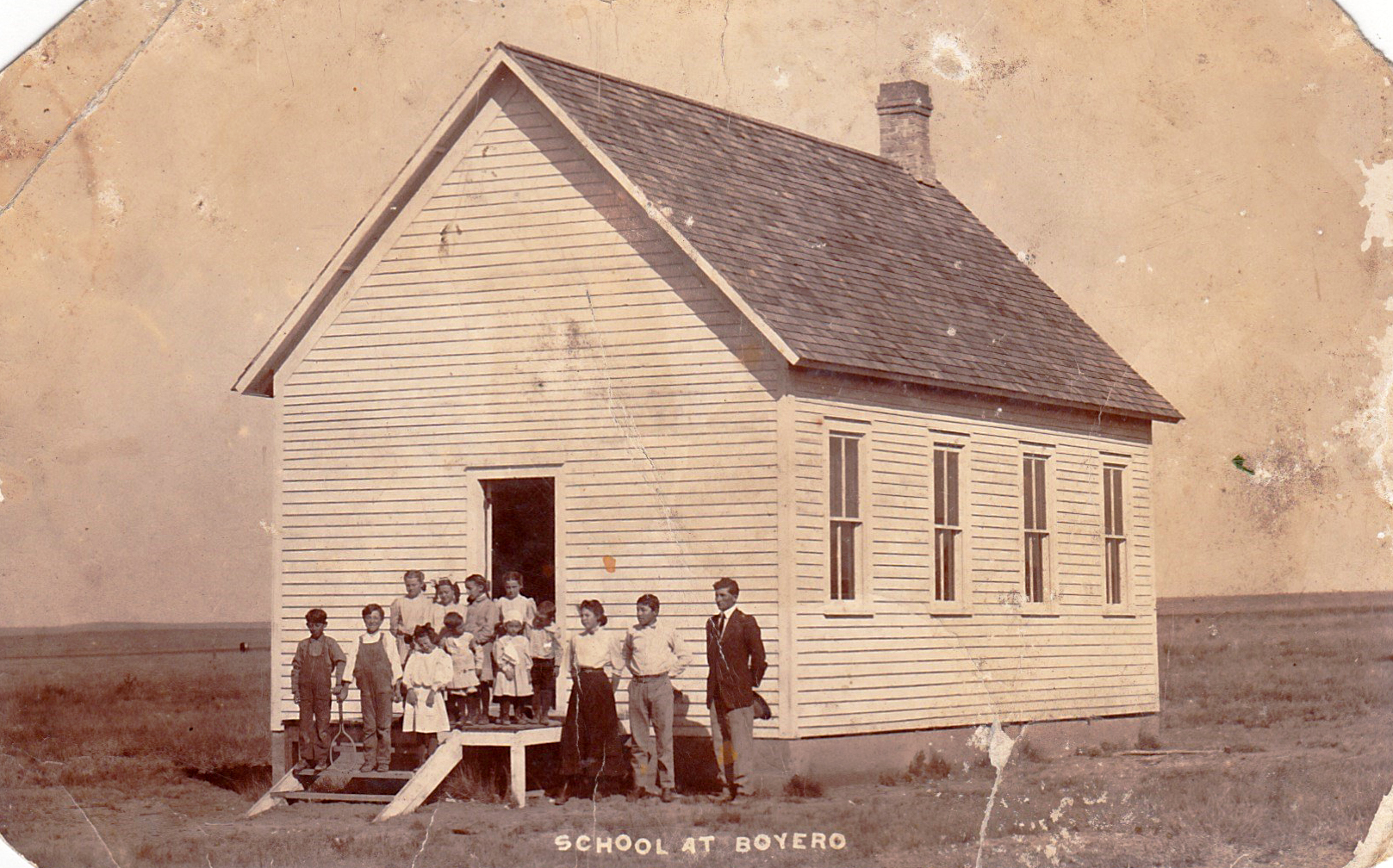Boyero was established by the Kansas Pacific Railroad in the late 1800’s, along with the towns of Genoa and Arriba. Located in Lincoln County, Boyero sits southeast of Limon about 34 miles, near Highway 287. Its local industry is reflected in the town’s name — Boyero is Spanish for oxherd or drover, i.e., one who tends grazing cattle or sheep.
The Boyero post office was established in 1902 and remained in operation until 1973. Boyero, which is no longer an incorporated town, is now served by the post office at Hugo, the county seat. I was unable to find out how many people live in current-day Boyero.
I count 13 people in this postcard picture. This was probably a classic one-room school, with students being taught in grades 1 through 8. Note that the two boys on the far left are both holding on to a single tennis racquet. The author of this card proudly asserts, “I am going to send you this just to show you that Boyero has a school house.”
Perhaps it was this school for which the “Boyero School Report” was published on March 7, 1914 in the “Range Ledger” newspaper, which was based in Hugo and published from 1899 to 1935. The report states that, for the month ending February 27th, those “neither absent nor tardy” were Willis Graham, Genevieve Schnebly, and Elsworth Schnebly; those “tardy but not absent” were Lunnie Masden, Hazel Williams and Helen Overman; and “those absent but not tardy ” (?) were John Cullen, Catheryn Cullen, Margaret Cullen, Rosanna Cullen, Bradley Davis, Francis Davis, Harold Graham, Henry Schnebly, Ruth Naldrett, Virgil Naldrett, Wilber Lane, Pearle Shroff, and Hobart Knight. The teachers were H.R. Graham, Jr., and Miss Era K. Arnold. I wonder if the man on the right in the tie and the woman second from right are Graham and Arnold.
The “Range Ledger” was a place for Boyero area ranchers to publicly post their brands and respective grazing territories. This practice points to a time when there was open- or free-range grazing. A sample posting in the “Ledger” was that of “Lucas & McKain” on December 3, 1903. They identified their grazing territory as the Big Sandy River area. Their brand was a bar over a Z and an upside-down Y. According to Wikipedia, this would be called the “Bar Z Crazy Y.”
I came across stories in the “Range Ledger” which illustrate the human propensity for mischief and fun. In the issue dated November 8, 1913, “You Know,” the writer of the Boyero column “South Boyero Breezes,” reports that that year’s Halloween “was a fine evening and next morning you could see where goblins and witches had been, and left their traces of mischief in misplacing various things.” In another column titled “Gleanings from around Dudley’s Store,” the author, “A Homesteader,” reported that several people “were at Dudley’s Hallowe’en night, listening to the phonograph. Those present were: Frank Miller and family, Edgar Welch, Misses Stella Welch, Maude Barringer, Edna Farrell, Gena Kravig, and Emmett Webb and Fred Cain. When Mr. Welch got ready to go home, his buggy had left the horse, and they had to take a lantern and go on a hunt for it. They found it out on the prairie, about a quarter of a mile from the house.”
REFERENCES:
- “Colorado Encyclopedia – Lincoln County ” at https://coloradoencyclopedia.org/article/lincoln-county
- Merriam-webster.com at https://www.merriam-webster.com/dictionary/drover
- “Range Ledger” issues dated December 3, 1903 , March 7, 1914, and November 8, 1913, at https://www.coloradohistoricnewspapers.org )
- SpanishDict at https://www.spanishdict.com/translate/boyero
- Wikipedia.org at https://en.wikipedia.org/wiki/Boyero,_Colorado
- Wikipedia.org at https://en.wikipedia.org/wiki/Livestock_branding


